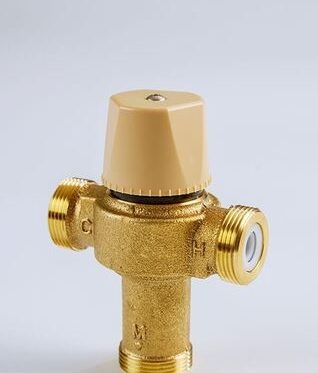A thermostatic expansion valve, or TXV, is a throttling device used in refrigeration systems and air conditioners. It regulates the amount of liquid refrigerant that is fed into the superheat evaporator of a system.
Thermostatic Expansion Valve Components
Although there are different types of TXVs, all of them have a few components in common. The TXV valve body houses the components and has a hole in the interior that prevents the refrigerant from escaping.
Within the valve body, you will find a metal diaphragm that is strong, thin, and flexible. Its ability to flex allows it to exert pressure onto a pin or needle that moves up and down to control the flow of refrigerant. A spring within the TXV counteracts the force of the pin and brings the pin back to its starting position. Finally, a sensing bulb and capillary line measure the temperature of the refrigerant at the evaporator exit.
How the TXV Works
A TXV regulates the refrigerant metered to the evaporator coil to keep it in a state of superheat, which is the most effective way to run a condenser. Changes in heat load and liquid pressure trigger this regulation. Within a TXV, there are three different forces at work: bulb pressure, spring pressure, and evaporator pressure.
In its operation, the TXV prevents high-pressure liquid refrigerant from entering the condenser and maintains control over how much refrigerant passes into the evaporator. When high-pressure liquid refrigerant passes through the small orifice in the cooling system, the pressure of the refrigerant reduces, causing part of the refrigerant to vaporize. The refrigerant, which is now part liquid and part vapor, is then sent over the evaporator and absorbs heat from the air, creating a cooling effect.
The refrigerant is exposed to more thermal energy as it passes through the evaporator, and it begins to increase in temperature. The TXV sensing bulb mounted at the evaporator’s outlet monitors this temperature change to maintain control of the refrigerant within the main valve body. The sensing bulb also contains a small amount of refrigerant that is closed off from the rest of the system.
When the heat of the refrigerant flowing over the evaporator increases, the temperature of the refrigerant within the sensing bulb also increases. As the refrigerant within the small area of the bulb heats up, an increase of pressure within the bulb pushes down on the TXV diaphragm via the capillary tube. The diaphragm descends, allowing more liquid refrigerant to enter the evaporator through the valve.
This repeats until the diaphragm reaches pressure balance. The spring and evaporator pressures operating at the top and bottom of the diaphragm balance the sensing bulb pressure at the top. Less liquid refrigerant evaporates in the coil when the evaporator load reduces. The extra liquid goes to the drain. The feeler bulb cools down, lowering the pressure and temperature.
The diaphragm moves upward due to the pressure, limiting the valve opening and, as a result, reducing refrigerant flow to the evaporator. The evaporator pressure drops as a result of this. It repeats until diaphragm pressure balance succeeds.
Benefits of a Thermostatic Expansion Valve
Automatic Refrigerant Flow Adjustment
The main function of the TXV is to adjust the flow of refrigerant into the evaporator according to the heat load in the system. When the heat dissipated by the system increases or decreases, the TXV immediately addresses these temperature fluctuations.
Preventing Compressor Breakdowns
By ensuring that all of the liquid refrigerant vaporizes in the evaporator, the thermostatic expansion valve prevents refrigerant particles from reaching the compressor. Any refrigerant that reaches the compressor can be detrimental to its operation, making the TXV a critical component in any cooling system.
Better Temperature Control
The thermal expansion valve’s capacity to adjust refrigerant flow allows the enclosure’s temperature to stay within a much smaller range. Capillary tubes often provide a continuous refrigerant flow, making it difficult to respond quickly to changing heat loads. Thermostatic expansion valves help to keep the temperature of the enclosure closer to the set point. A TXV is an active device, and it can keep temperature much closer to the set point than a passive device can.
Keeps the Evaporator Running
The evaporator can be active during the cooling process thanks to the thermostatic expansion valve. The valve also ensures that the evaporator performs optimally by continuously adjusting the flow of the modified superheated refrigerant.
Increased Power Efficiency
The TXV allows the enclosure air conditioner to run at maximum efficiency to handle the heat load. By optimizing the flow of refrigerant, the valve reduces the work of the compressor. Over time, this significantly reduces wear and tear and allows an air conditioner to provide the same level of comfort with much less effort.
Common TXV Problems
Like any other mechanical component, thermostatic expansion valves experience problems from time to time. The capillary tube of the sensing bulb is one of the TXV parts that can be susceptible to failure. Typically, tubes made of stainless steel outperform those made of other metals, such as copper. The TXV power element is also a common point of failure. Again, the material used plays the biggest role in this component’s longevity. Stainless steel is also the best material to use for a TXV power element. High-quality stainless steel power elements can last at least 200,000 cycles.
If any TXV components fail, the entire cooling system, including the compressor, evaporator, and condenser, will be starved of refrigerant. This can lead to a number of symptoms. Some of the most common include:
- Low condensing pressure
- Low evaporator pressure
- Excessive compressor and evaporator superheats
- Short cycling
- Low compressor amp draw
A malfunctioning thermostatic expansion valve may also cause the cooling system to blow warm air, and the compressor may run constantly. In addition, frost may form on the evaporator. Because these issues can be caused by other problems within the system, it is important to turn to an experienced heating and cooling company for an accurate diagnosis.
Your Cooling and Heating Experts
At Reliable Air Conditioning, we specialize in providing top-notch air conditioning services to commercial and residential customers throughout Mesa, AZ, and the surrounding area. Our team of licensed and trained HVAC technicians can accurately diagnose your cooling issue and provide a timely repair to restore your comfort. We are committed to customer satisfaction and offer honest pricing on all of our services. You can rely on our team to show up on time and with all of the tools needed to complete your AC repair without delay. We specialize in Lennox and Mistubishi systems but have the knowledge and skills to work on units of all makes and models.
In addition to cooling repair, maintenance, and installation, our family-owned company provides a full range of heating services, including those for radiant heating systems. We also work on ductless mini-splits and provide indoor air quality solutions. Reach out to our team today to learn more about our services or to set up an appointment.



